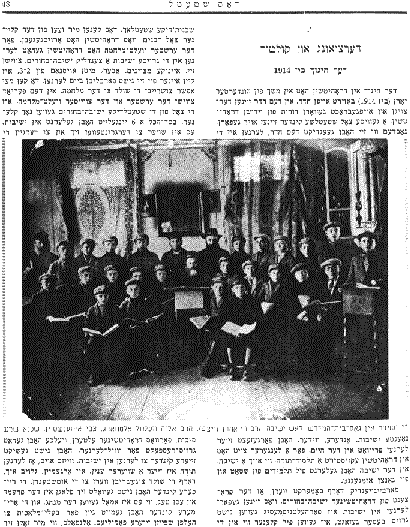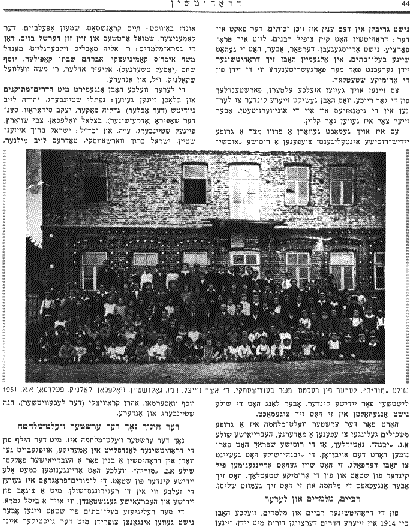Previous Page
|
Next Page
 [
Page 43
]
[
Page 43
]
6.
EDUCATION AND CULTURE
Education before 1914
For hundreds of years (prior to 1914) education in Drohitchin was based on the
kheder.
Generations of Drohitchin Jewish boys were educated and trained in the
kheder.
After finishing the
kheder,
a certain number of local children also traveled to study in nearby yeshivas.
Others continued with their education privately at home. For an extended period
of time there were a Jewish religious elementary school and a yeshiva in
Drohitchin, and the yeshiva was filled with students from Drohitchin and other
places in the surrounding region.
[Photo:] The yeshiva in the Street House of Study. The head of the yeshiva,
Rabbi Aharon (seated), Rabbi Eliyahu Velvel Altvarg, Zvi Eisenstein, Shakhna
Shamash.
It should be noted that the
percentage of Drohitchin yeshiva students who traveled to study in yeshivas was
actually not that large, and was smaller than in neighboring towns. This fact
is indicated by the small number of rabbis that Drohitchin produced. Before
World War I, there were around a dozen yeshiva students, including some
outstanding ones, from Drohitchin in the large yeshivas. However, except for 2
or 3, none of them remained a student, and this fact can probably be attributed
to the war. In the inter-war period, the number of local yeshiva students
decreased even further. There were only 6 students studying in the yeshivas. It
is difficult to understand the reasons why parents in Drohitchin, who had great
respect for scholars, didn't send their children to study in the yeshivas.
Apparently, studying Torah is a very difficult undertaking. In general, I
believe that the reason can be attributed to circumstances; the wealthy
children didn't want to have to face eating their meals at the homes of
strangers, as was once the usual custom. The poor children were forced to work
with craftsmen to help support their families. We really don't have to
 [
Page 44
]
[
Page 44
]
speculate and try to give the benefit of the doubt. The fact is that Drohitchin
didn't produce many rabbis in relation to the size of the town. Drohitchin did,
however, have fine householders. In general, Drohitchin Jews were considered
more advanced than those of nearby towns.
There were also parents from
among the wealthiest residents who sent their children to study in the
gymnazia
high schools and in university. These were very few, however. There was also
an attempt by Russian-Jewish secularists to open a Russian school for Jewish
children. The school didn't last long, however, and it closed rather quickly.
Just before World War I a group
of followers of the Enlightenment wanted to open a modern Hebrew school called
Yavneh. Naturally, Russian was held in high esteem, and the school looked like
it was going to succeed. Many children from town and surrounding towns started
studying there. However, the war intervened, and the school was forced to close.
Rabbis, religious and secular teachers
The well-known rabbis and teachers who educated generations of Jews in
Drohitchin were: Chaim Kronstadt, Shimon Appelbaum, the Kaminitzer, and Shmuel
Artshes and his son, Hershel Baum. The Talmud instructors were: R. Eliyahu
Makhlis Zilbergleit, Mendel Moshe Isser's Kaminetsky, Avraham Shabtai Kapuller,
Yosef Shakhat (Yossel Tchernas), Eliezer Adler, R. Moshe Velvel Shkolnick, and
others.
The secular teachers who taught
the modernized elementary school classes were: Naftali Steinberg, Yehudah Leib
Neiditch (the Reciter), Gedaliah Sacker, Yaakov Sidorov, Sender Shapiro (from
Odrezshin), Bezalel Wolfson, Zvi Schwartz and Feigel Steinberg. These are
deceased, and the following are still living: Yisrael Baruch Eisenstein,
Yisrael Baruch Warshavsky, Todres Leib Milner, Yosef Wasserman, Aharon
Kravitsky (from Lekhovitch), Chana Steinberg and others.
[Photo:] The Moriah School. Teachers from right: Moshe Bezdzhesky, R. Asher
Weizel, Remz, Goldstein, Wolfson, Kolnick, Feldman et al. 1931.
Education after World War I
With the assistance of
Drohitchin émigrés in America, a building was constructed in
Drohitchin after the First World War to house the Hebrew school, Moriah, which
took in almost all the children in town. The educational program was the same
as in the government schools, but also offered classes in Yiddish and Hebrew
subjects, as well as some Talmud.
The more religious householders
in town weren't entirely satisfied with the
Previous Page
|
Next Page
This material is made available by JewishGen, Inc.
and the Yizkor Book Project for the purpose of
fulfilling our
mission of disseminating information about the Holocaust and
destroyed Jewish communities.
This material may not be copied,
sold or bartered without JewishGen, Inc.'s permission. Rights may be
reserved by the copyright holder.
JewishGen, Inc. makes no representations regarding the accuracy of
the translation. The reader may wish to refer to the original material
for verification.
JewishGen is not responsible for inaccuracies or omissions in the original work and cannot rewrite or edit the text to correct inaccuracies and/or omissions.
Our mission is to produce a translation of the original work and we cannot verify the accuracy of statements or alter facts cited.
 Drogichin, Belarus
Drogichin, Belarus
 Yizkor Book Project
Yizkor Book Project
 JewishGen Home Page
JewishGen Home Page
Yizkor Book Director, Lance Ackerfeld
This web page created by Lance Ackerfeld
Copyright © 1999-2025 by JewishGen, Inc.
Updated 7 Dec 2001 by LA
 [
Page 43
]
[
Page 43
]



